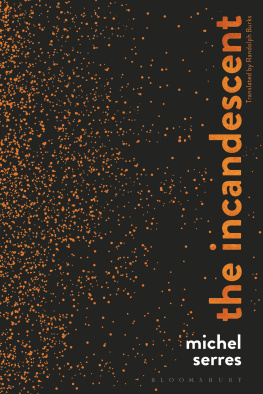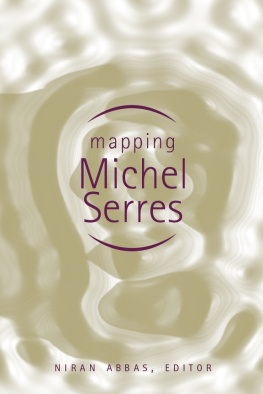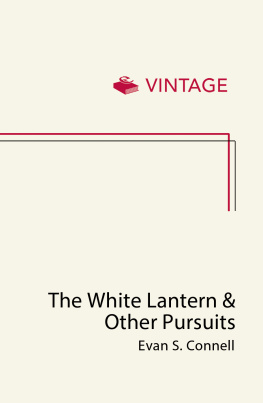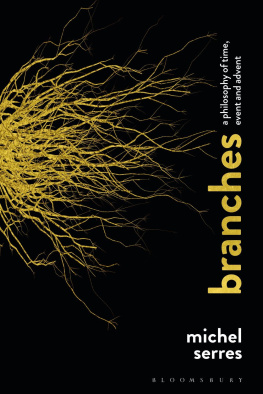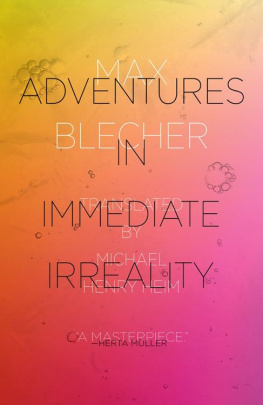Serres - The Incandescent
Here you can read online Serres - The Incandescent full text of the book (entire story) in english for free. Download pdf and epub, get meaning, cover and reviews about this ebook. City: London, year: 2018, publisher: Bloomsbury UK;Bloomsbury Academic, genre: Romance novel. Description of the work, (preface) as well as reviews are available. Best literature library LitArk.com created for fans of good reading and offers a wide selection of genres:
Romance novel
Science fiction
Adventure
Detective
Science
History
Home and family
Prose
Art
Politics
Computer
Non-fiction
Religion
Business
Children
Humor
Choose a favorite category and find really read worthwhile books. Enjoy immersion in the world of imagination, feel the emotions of the characters or learn something new for yourself, make an fascinating discovery.
- Book:The Incandescent
- Author:
- Publisher:Bloomsbury UK;Bloomsbury Academic
- Genre:
- Year:2018
- City:London
- Rating:3 / 5
- Favourites:Add to favourites
- Your mark:
- 60
- 1
- 2
- 3
- 4
- 5
The Incandescent: summary, description and annotation
We offer to read an annotation, description, summary or preface (depends on what the author of the book "The Incandescent" wrote himself). If you haven't found the necessary information about the book — write in the comments, we will try to find it.
The Incandescent — read online for free the complete book (whole text) full work
Below is the text of the book, divided by pages. System saving the place of the last page read, allows you to conveniently read the book "The Incandescent" online for free, without having to search again every time where you left off. Put a bookmark, and you can go to the page where you finished reading at any time.
Font size:
Interval:
Bookmark:

THE INCANDESCENT
Also Available from Bloomsbury
The Five Senses , Michel Serres
Times of Crisis , Michel Serres
Statues , Michel Serres
Rome , Michel Serres
Geometry , Michel Serres
For e. marguerite.
THE INCANDESCENT
Michel Serres
Translated by Randolph Burks

Contents
At the end of the lane rising through the forest, positioned on a tall grassy hillock, surrounded by a torrent descending from the mountain, a farm and its annexes overlook a cirque dominated by glaciers. Beneath the morning sun and the motionless air, this view, this landscape, this scene reveal to me, in an ecstatic epiphany, the quiet presence of the things in their exact place. Transparent and wide, space here seems to swallow up time, suspended.
Descent into duration
In front of the door of the house built at the foot of alpine pastures, a little girl of three is playing; as a birthday gift yesterday, she received a cream pink doll with green pants. Behind her, the calm facade with stone lintels still shines with the ochre paint applied with a great deal of effort back when the hay harvest abounded seven years ago. Her grandfather built the metal shed to the left of the main building, itself constructed at the beginning of the last century on the ruins of an old windmill erected in the location of an ancient monastery set up long ago on the premises of a temple whether Roman or Gallic, we have forgotten in front of rocks moved by a thousand-year-old flood on the part of this dancing and malicious torrent whose course is dug into the Jurassic strata of the mountains enclosing the semicircular horizon beneath snows said to be eternal.
The toy comes from a store; the little girl no longer babbles and already talks; the paint job dates from recent years, with a mild climate, the new building from before the warm years when the glaciers began to recede, the windmill from the last century, the monastery from the Early Middle Ages, the old stones from before Jesus Christ, the flood from more than a thousand years ago, the mountain from the Tertiary ... As though by steps or degrees, I distinguish the fragile toy in front of the frail child leaping and running in front of the open door, the light shed in front of the heavy rocks, the house in front of the river and the river in front of the high black wall, a millionaire in years, beneath the dazzling Sun, a billionaire star.
How long has the little girl played with the doll? When did her father paint the facade? I easily remember. When did the first occupants of this place erect those stones? This requires more expertise. How long has the torrent flowed, the glacier descended from its bergschrund, the mountain risen to three thousand metres? How long has the sun shone? With datings that are now exact, knowledge answers these questions concerning my perception,
Little balconies of space-time
In a few days the doll, in torn clothes, will be missing an arm, soon pulled off; in two years the child will have to leave for school in the morning. These walls will still be standing; she will believe them to be immobile her entire life, at least lasting. Her father who coated them because he saw them wearing away has, ever since his own childhood, thought that the mountain was stable. Leaning back against rocks he believed to be unchanging, he noticed that the stones come loose with time and stabilized their rickety breaches with rubble stone extracted from the nearby mountain wall; he built with the hard immobile, drawn from a quarry dug out in width, height and depth. In front of the farm she believes to be eternal, the little girl already regrets having damaged the toy she is holding in her hand and sometimes lifts to her mouth.
Behind the child, the wall; behind the father, the mountain: each of them perceives, twice, something stable. In front of them, the little torn clothes or the denuded facade: each of them perceives, twice, something moving. So daughter and parent believe they are bustling about on a kind of balcony, on a small step of space behind them, upstream and of time in front of them, downstream.
The rose and the gardener
On their narrow and respective terraces, each one, with their backs to space and looking at time, could say with Fontenelle that as far as any rose can remember, no gardener has ever been seen to die. The latter sees the former be born, open, wilt and then disappear with the passing of time, but if the flower could see or feel, it would admire the ever so slow movements of its cultivator, stable and immune to wear, in space. For the little girl, the farm doesnt budge, and her father in his turn knows, like his entire line, that mountains are not moved. Upstream from these two lives, fast like roses, devoted to wear and decline, we find spatial stability, the house and mountain playing, lets say, the role of the gardener; here are two levels composed, as I have risked saying, of a space and a time. Sitting on a solid riverbank, parent and child watch a river flow. In front of the immarcescible construction, the roses lose their petals; the house is erected, wears away and crumbles in front of the impeccable mountain wall, whose rock folds and erodes beneath an eternal sun: for every stance, there are as many gardener illusions.
The scale by which these generations live doesnt exceed the traditions of their family, but a historian would date the constructions: farm, windmill, cloister, temple, ruins, traces, marks of men who have vanished. He adds a few other levels. Each of them only preserves a human memory, one thats lacunary, sometimes written in signs, most often practical and leaving behind a few worked objects. Lets call all our history: the gardener illusion. Like the child, we foolishly believe that civilizations and their works develop in the invariant expanse of a world that welcomes them, in short, that a geography unfolding in a local or global space conditions the duration, whether short or long, of prehistory and history, like the set of a theatre in which the action would take place. But a geologist would date this set again, for it flows as much as the torrent.
The torrent and the Grand Canyon
In front of the furious flood, sweeping away with it rocks, pebbles and sand, we also foolishly say that this current tears these alluvia away from mountains that seem to us to be stable in space; we speak of erosion, as though an active flow were wearing away a passive bedrock that was always already there, like a rare channel in a massif. No, the water flows, but the cliff flows as well since it collapses into blocks and fine sands, like water and human history, in as many and even more stages or levels. Solids flow just as much as fluids do; a bit harder, more resistant, it takes them longer. If the mountain could perceive, it would see things be born and disappear downstream from it and would believe, once again, itself to be leaning back upstream, if I may, and while it folds, rises, erodes and disappears against a space in which the sun changes as little as the gardener before his roses: as far as any volcano can remember, no star has ever been seen to age. Behind the few hundred tiers of short-schemed history unfurl millions of levels in which the entire Universe enters into time.
At the bottom of its red gorges, the Colorado flows, but the crystals gripped in the different strata of the canyons cliffs flow as well. From the south rim of its theatrical fault or in front of the modest farm where the child plays, you dont see two different spectacles in a similar space but a succession of a thousand springs having diverse rhythms. Of course, one spring flows at the bottom of the channel your open eyes follow without any amazement, but the others fall more and more slowly without you directly perceiving them. I invite you to see them, not motionless but slow. Imitating Galileo, I will gladly say: And yet all these red cliffs flow. To the historians and the geologists datings are added those of the geophysicist and the chemist, who, in discovering for example how uranium turns into lead, calculate the age of the Earth: four billion years; following them is the astrophysicist, who reckons the age of the Universe, fifteen billion since the big bang, if it ever occurred, and calculates the end of the entire process in what he calls the big crunch, the terminal catastrophe in a punctual crushing. So I can no longer contemplate sun, stars and landscapes without their time carrying my eyes and body away with its tremendous flood. Yes, knowledge feeds and reverses vision.
Font size:
Interval:
Bookmark:
Similar books «The Incandescent»
Look at similar books to The Incandescent. We have selected literature similar in name and meaning in the hope of providing readers with more options to find new, interesting, not yet read works.
Discussion, reviews of the book The Incandescent and just readers' own opinions. Leave your comments, write what you think about the work, its meaning or the main characters. Specify what exactly you liked and what you didn't like, and why you think so.

